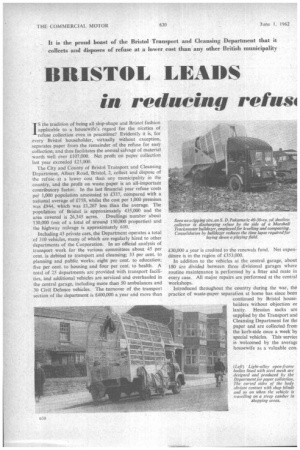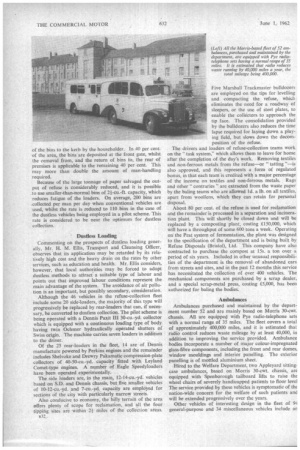BRISTOL LEADS
Page 64

Page 65

Page 66

Page 67

If you've noticed an error in this article please click here to report it so we can fix it.
in reducing refus4
IS the tradition of being all ship-shape and Bristol fashion applicable to a housewife's regard for the niceties of refuse collection even in peacetime? Evidently it is, for every Bristol householder, virtually without exception, separates paper from the remainder of the refuse for easy collection, and thus facilitates the annual salvage of material worth well over £107,000. Net profit on paper collection last year exceeded £23,000.
The City and County of Bristol Transport and Cleansing Department, Albert Road, Bristol, 2, collect and dispose of the refuse at a lower cost than any municipality in the country,' and the profit on waste paper is an all-important contributory factor. In the last financial year refuse costs per 1,000 population amounted to £337, compared with a national average of £758, whilst the cost per 1,000 premises was £944, which was £1,267 less than the average. The population of Bristol is approximately 435,000 and the area covered is 26,345 acres. Dwellings number about 130,000 (out of a total of around 150,000 properties) and the highway mileage is approximately 610.
Including 43 private cars, the Department operates a total of 310 vehicles, many of which are regularly hired to other departments of the Corporation. In an official analysis of transport work for the various committees about 45 per cent. is debited to transport and cleansing; 33 per cent. to planning and public works; eight per cent. to education; five per cent. to housing and four per cent. to health. A total of 25 departments are provided with transport facilities, and additional vehicles are serviced and overhauled in the central garage, including more than 50 ambulances and 30 Civil Defence vehicles. The turnover of the transport section of the department is £400,000 a year and more than £30,000 a year is credited to the renewals fund. Net expen diture is in the region of £353,000.
In addition to the vehicles at the central garage, about 180 are divided between three divisional garages where routine maintenance is performed by a fitter and mate in every case. All major repairs are performed at the central workshops.
Introduced throughout the country during the war, the practice of waste-paper separation at home has since been continued by Bristol house holders without objection or laxity. Hessian sacks are supplied by the Transport and Cleansing Department for the paper and are collected from the kerb-side once a week by special vehicles. This service is welcomed by the average housewife as a valuable con venience, despite the necessity to avoid, as far as possible, he inclusion of Cellophane and polythene wrapping. The :Japer is purchased on long-termt contract by St. Anne's Board Mills and last year the total exceeded 15,000 tons. kbout 150,000 hessian sacks are replaced by the Departneat annually.
Based on B.M.C. and Bedford 30-cwt. chassis, 17 vehicles tre engaged in paper collection and all are titted with .pecial light-alloy bodies, designed and produced in the workshops. These are constructed of standard aluminium ection's and comprise an openwork frame lined with steel nesh. The body is extended at the front to form a Luton ;ompartment over the cab and the sides are curved inwards o avoid contact with shop blinds t.tcl so on, when the vehicle is ravelling on a steep camber in hopping areas. Capacity of the )ody is around 300 sacks.
The main advantage of using iluminium is its durability cornmred with ;timber, and this far iutweighs its higher cost, its light veight being a secondary, but important, consideration. Three of the bodies were recently transferred to new chassis after being in use tor 10 years. Aluminium is also used fqr the construction of orderly trucks and of bins for litter and sand.
A factor favourable to refuse-collection economy is the relatively large proportion (20 per cent.) of the dwellings that have no secondary acceSs, which necessitates transfer of the bins to the kerb by the householder. In 40 per cent. of the area, the bins are deposited at the front gate, whilst the removal from, and the return of bins to, the rear of premises is applicable to the remaining 40 per cent. This may more than double the amount of man-handling required.
Because of the large tonnage of paper salvaged the output of refuse is considerably reduced, and it is possible to use smaller-than-normal bins of 21-cu.-ft. capacity, which reduces fatigue of the loaders. On average, 200 bins are .collected per man per day when conventional vehicles are used, whilst the rate is reduced to 110 bins in the case of the dustless vehicles being employed in a pilot scheme. This rate is considered to be near the optimum for dustless collection.
Dustless Loading Commenting on the prospects of dustless loading generally, Mr. H. M. Ellis, Transport and Cleansing Officer, observes that its application may be retarded by its relatively high cost and the heavy drain on the rates by other services, such as education and health. Mr. Ellis considers, however, that local authorities may be forced to adopt dustless methods to attract a suitable type of labour and points out that improved labour conditions represent the main advantage of the system. The avoidance of air pollution is an important, but possibly secondary, consideration.
Although the 46 vehicles in the refuse-collection fleet include some 20 side-loaders, the majority of this type will progressively be replaced by rear-loaders that can, if necessary, be converted to dustless collection. The pilot scheme is being operated with a Dennis Paxit III 30-cu.-yd. collector which is equipped with a continuous loading type of body having twin Ochsner hydraulically operated shutters of Swiss origin. The machine carries seven loaders in addition to the driver.
Of the 25 rear-loaders in the fleet, 14 are of Dennis manufacture powered by Perkins engines and the remainder includes She'yoke and Drewry Pakamatic compression-plate collectors of 40-50-cu.-yd. capacity fitted with Leyland Comet-type engines. A number of Eagle Speedyloaders have been operated experimentally.
The side loaders are, in the main, 12-14-cu.-yd. vehicles based on S.D. and Dennis chassis, but five smaller vehicles of 10-12-cu.-yd. and 7-cu.-yd. capacity are employed for sections of the city with particularly narrow streets.
Also conducive to economy, the hilly terrain of the area offers plenty of scope for reclamation, and all the four tipping sites are within 2-1miles of the collection • areas. Five Marshall Trackmaster bulldozers are employed on the tips for levelling and compacting the refuse, which eliminates the need for a roadway of sleepers, or the use of steel plates, to enable the collictors to approach the tip face. The consolidation provided by the bulldozers also reduces the time lapse required for laying down a playing field, but slows down the decomposition of the refuse.
The drivers and loaders of refuse-collection teams work on the " task system," which allows them to leave for home after the completion of -the day's work. Removing textiles and non-ferrous metals from the refuse—or "tatting "—is also approved, and this represents a form of regulated bonus, in that each team is credited with a major percentage of the income on textiles and non-ferrous metals. Rags and other " contraries " are extracted from the waste paper by the baling teams who are allowed lel. a lb. on all textiles, apart from woollens, which they can retain for personal disposal.
About 80 per cent. of the refuse is used for reclamation and the remainder is processed in a separation and incineration plant. This will shortly be closed down and will be replaced by a composting plant, costing £150,000, which will have a throughput of some 600 tons a week. Operating on the Prat system of fermentation, the plant was designed to the specification of the department and is being built by Refuse Disposals (Bristol), Ltd. This company have also contracted to purchase the compost at 15s. a ton over a period of six years. Included in other unusual responsibilities of the department is the removal of abandoned cars from streets and sites, and in the past 12 months this service has necessitated the collection of over 400 vehicles. The mechanical components are purchased by a scrap dealer, and a special scrap-metal press, costing £5,000, has been authorized for baling the bodies.
Ambulances
Ambulances purchased and maintained by the department number 52 and are mainly based on Morris 30-cwt. chassis. All are equipped with Pye radio-telephone sets with a normal range of 35 miles. The fleet covers a total of approximately 400,000 miles, and it is estimated that radio control reduces waste mileage by at least 40,000, in addition to improving the service provided. Ambulance bodies incorporate a number of major colour-impregnated glass-fibre components, including the front and rear domes, window mouldings and interior panelling. The exterior panelling is of mottled aluminium sheet.
Hired to the Welfare Department, two Appleyard sitting. case ambulances, based on Morris 30-cwt. chassis, are equipped with Spenborough tailboard lifts to raise tilt wheel chairs of severely handicapped patients to floor level The service provided by these vehicles is symptomatic of the nation-wide concern for the welfare of such patients and will be extended progressively over the years.
Other vehicles of interesting design in the fleet of 94 general-purpose and 34 miscellaneous vehicles include is
There is always a first choice in everything. In public service road transport it is, undoubtedly, Leyland. In the U.K. the majority of bus-operating municipalities rely on Leyland's greater experience, wider range and unequalled economy and reliability. The same goes for overseas, where, in more than thirty capitals and on hundreds of city and inter-city routes, Leylands sweep the board.
Leyland build buses which vary in size and purpose from 26-seaters for personnel service, through a range of medium and large single-deckers to 78-seater double-deckers for urban and long distance operation. And all of them have a time-proved reputation for low running costs, a long trouble-free working life and steadfast reliability. All qualities which have taken Leylands to the top of the world's poll in the choice for public service transport.






































































































































































